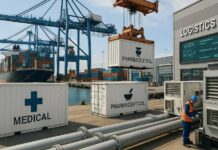As per the recent researches that have been done, the global water and wastewater treatment equipment market that was valued at $64.5 billion in 2023 is expected to hit $68.7 billion in 2024 is anticipated to reach $85 billion in 2030 and likely to reach $107.5 billion by 2033 at a CAGR of around 5% between 2023 to 2033.
The Water and Wastewater Treatment Equipment Market growth happens to be pushed by rising water scarcity apprehensions, which in a way goes on to drive the adoption of practices that are related to sustainable water management. The growth comes due to industrial water consumption as well as discharge and the rising global population, in addition to a surge in stringent regulations by governments for wastewater emissions that drive the global market.
In terms of product type, this market has been segmented into filtration, desalinization, disinfection, biological, sludge treatment, testing, etc.
Filtration, as a matter of fact, will account for the largest share of all when it comes to value across the worldwide market in 2024.
There are numerous key elements behind filtration ahead compared to others. For starters, filtration is the most basic and necessary step when it comes to water treatment processes, irrespective of the source or the kind of water that’s treated. The filtration systems go on to eradicate contaminants, suspended solids, and impurities, thereby enhancing the quality of water and making it apt for drinking, agri-use, and industrial processes. Apart from this, due to rising challenges in terms of water pollution that leads to healthcare challenges and the requirement for clean water across the world, there happens to be a growing demand when it comes to dependable and effective filtration solutions. It is well to be noted that this demand is especially witnessed in fast developing regions, where water quality challenges are quite prevalent.
Moreover, advancements when it comes to filtration technologies like ultrafiltration and membrane filtration have gone on to elevate the effectiveness as well as flexibility of filtration systems, hence driving market growth further.
Stringent regulatory standards as well as environmental regulations are also one of the major reasons that happen to mandate the usage of filtration systems that are effective across wastewater plants along with industrial facilities.
When we talk of processes, the water and wastewater treatment equipment market happens to be segmented into primary, secondary, and tertiary segments, with the tertiary process happens to be accounting for the largest share when it comes to value in 2024.
The tertiary process goes on to play a very critical role when it comes to attaining the highest level of water quality benchmarks, specifically for wastewater treatment plants that are aiming to meet stringent regulatory needs. This process goes on to involve some very advanced treatment methods that range from disinfection, filtration to nutrient removal, which happen to be necessary for eradicating leftover contaminants as well as pathogens from the treated water right before its release to the environment or reuse across numerous applications.
Besides this, as worldwide water scarcity as well as pollution go on to intensify, there is indeed a rising stress on reusing wastewater, thereby pushing the relevance of tertiary treatment equipment and tech.
In terms of end users, the water and wastewater treatment equipment market has been segmented into both municipal and industrial. The municipal segment will comprise the largest share when it comes to value in 2024. This is because of the fact that the municipalities happen to be responsible for offering safe and clean drinking water to households and, at the same time, managing wastewater from households, public facilities, and commercial establishments.
In addition to this, the fast urbanization along with population growth within the urban sectors have led to increased pressure on the infrastructure, thereby pushing for upgrades and expansions of treatment facilities and processes. Furthermore, strict regulatory benchmarks as well as guidelines for the quality of water as well as environmental protection go on to mandate the municipalities to go ahead and invest in treatment technology and equipment that are advanced so as to make sure to safeguard public health and be on track in terms of compliance.
In terms of geography, Asia Pacific happens to be the largest region for this market due to rapid urbanization and industrialization in nations like India, China, and also Southeast Asian countries. This has indeed led to increased water pollution and scarcity, thereby driving the demand for advanced treatment solutions.
Strict regulations by governments when it comes to wastewater emissions drive the worldwide market
Significant governmental agencies such as the Central Pollution Control Board- CPCB, the European Environmental Agency- EEA as well as the US Environmental Protection Agency- EPA go on to play a very vital role when it comes to boosting the water quality of the environment and, at the same time, preventing water pollution.
Interestingly, climate change has indeed raised some level of awareness in terms of conserving and recycling natural resources such as water, as most of the population throughout the world faces the stress of water. There are many governments that are taking steps so as to strengthen the restriction part so as to take care of this problem.
The water and wastewater treatment equipment demand is all set to rise within the expected period because of stringent laws that are incorporated by governments across the world.
The expanding population of the region has also led to further requirements for it, and strict environmental regulations as well as policies that happen to be aimed at reducing water pollution and improving the quality of water have compelled municipalities as well as industries to go ahead and invest in modern water as well as wastewater treatment infrastructure.
It is worth noting that across numerous regions of the world, a massive amount of wastewater happens to be released into the environment and that too untreated or without sufficient treatment thereby causing environmental degradation as well as resulting in severe health risks for people.
It is a known fact that diseases can be as well carried out due to wastewater that has not been treated to its capacity, either fully or partially. It is indeed expected that rising urbanization, depletion of freshwater resources, and industrialization; all will lead to a surge in the need in terms of clean water and, at the same time, boost product demand.
Rising demand for clean water happens to make way for tremendous choices
The global demand when it comes to freshwater that is also treated is indeed rising due to the spurt in population, tech advancements and top it all, the infrastructural upgrades that are taking place. The fact is that water use has raised phenomenally in the last 50 years because of the over-doubling of the human population. As per the WHO, 2.2 billion people don’t have access to those services that take care of managing drinking water. This is indeed a challenge, as there are geopolitical tensions between China, India, and Bangladesh. Due to the limited availability of freshwater resources, wastewater treatment happens to be more critical than ever so that the rising demand for clean water can be looked into.


















